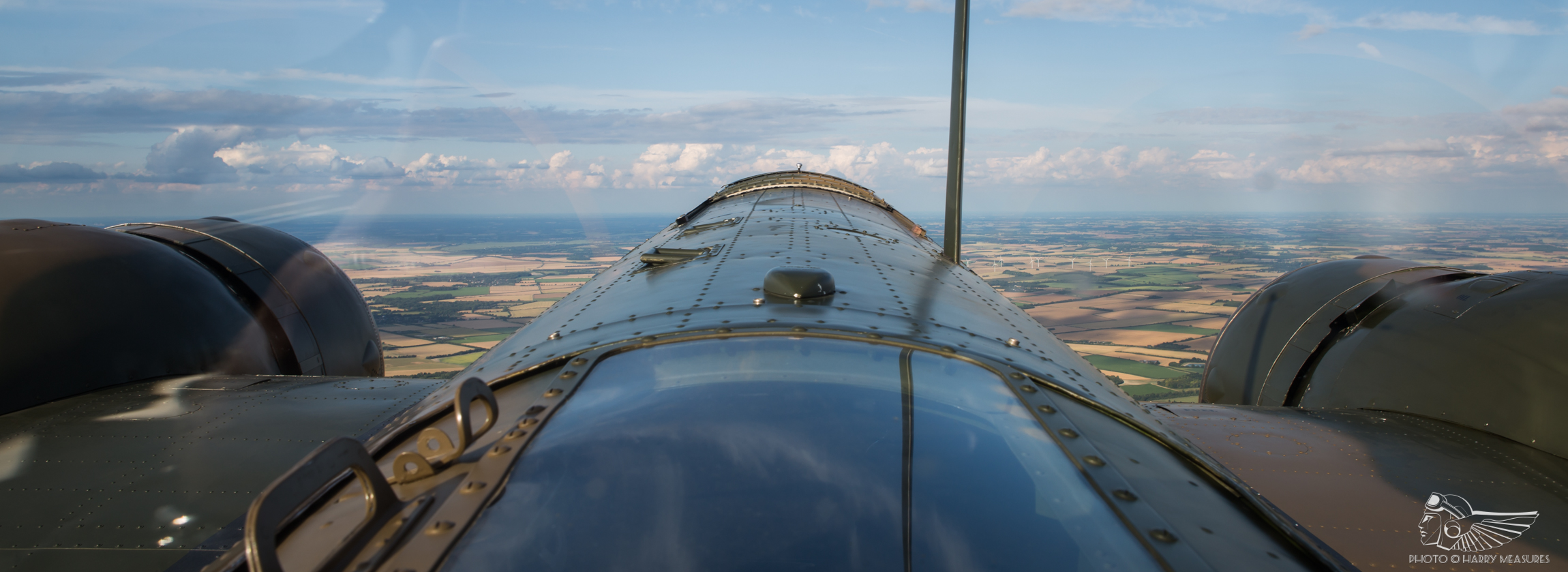Thursday evening before Flying Legends 2019, and much of the day’s rush was subsiding into a lovely calm, sun-kissed evening. Outside the Aircraft Restoration Company’s (ARCo) hangar and basking in the early evening light was arguably the jewel in the ARCo crown – the sole surviving Bristol Blenheim Mk.I(F). First flying post-restoration in late 2014 in the hands of John Romain, the early war bomber has been a staple of the UK historic aviation scene since. The aeroplane was due to fly later in the evening for a photo shoot, John pencilled in to do the honours. With the brief complete, the job of flight engineer was somewhat unceremoniously dropped on a good friend of mine (Matt, one of ARCo’s engineers at the time). At George Romain’s invitation, I had the pleasure of joining John and Matt to document the flight and write up the experience for ARCo’s in-house magazine, Engineered to Inspire, where this account was first published.
A comprehensive safety brief covered standard items such as escape routes, and less standard points – namely, how to not-at-all-elegantly enter the space above the gun pack for a view of the cockpit area in-flight. I was also given the low-down on the operation of the dorsal turret, which I’d be free to use once airborne and hydraulic power diverted away from the gear and flaps. Entering the aircraft from the ventral hatch just behind the trailing edge of the wing, you pull yourself up right in front of the jump seat. I was quite glad to avoid scaling up the side of the aircraft and entering through the top hatches – it’s something I’ve been lucky enough to do before, and believe me, it’s not as easy as those familiar with the aircraft make it look! With the brief all but complete, George joked, “It’s a wonder they ever hit anything with the turret. You’d have more luck throwing the gun at them!” and then, with a last thumbs up, closed the hatch above me and jumped down off the wing.
Sat alone in the Blenheim, there’s a brief moment to really take it in before we get going. The sides of the fuselage are quite busy with an assortment of tools, the electrical panel and master switch. Running down the centre of the fuselage floor are the control cables for the elevator and rudder, in a covered (but no-step) channel. The jump seat itself was a modification devised by the Canadians for use by a gunnery instructor (as such, not fitted to combat variants), and was incorporated in the restoration by ARCo as a safer (and less draughty) place for a third crew member. Up ahead, John and Matt jumped down into the cockpit, two silhouettes framed by the elegant glazing of the nose. In the back, the view outside (at least on the ground) is limited to a small porthole in the ventral hatch, and the large glazed hatch above you, making it all a bit distant as John goes through the start procedure. Outside, there are engineers readying the two Bristol Mercury engines – the primers are fitted in the gear wells in an effort to keep fuel out of the cockpit. Left then right, the engines rumble into life, and after a while with them just warming through at idle power, we move off towards the hold.
You really get a sense of the power of the engines during the run-up, the airframe bucking and juddering as each engine is opened up in sequence, the propellers cycled twice from fine to coarse, and then a mag check at +0lb boost. With both engines and systems ready to go, we move off towards to Runway 24, the taxiway centreline flashing in the window between my feet. Lined up on the hard runway, I catch John running through one last checklist, closing the cooling gills and ensuring the propellers are in fine pitch before we begin our take-off roll. The tail comes up fairly quickly (which is a fantastic sensation in itself), and soon the view between my feet shows the fields to the south of Duxford, steadily getting smaller. Still unable to see the horizon from the jump seat, I’m glad of the window in the escape hatch as a bit of a reference. Not far into the climb and John calls out on the intercom to let me know I can move about, and importantly, have a go in the turret.
Operated almost entirely from a small handlebar type control yoke, the turret sits deep in the fuselage when not in use; as such, you effectively squat over the seat when you first enter. Squeezing a large trigger on the left hand grip energises the turret, twisting the grips away from you will depress the gun (so as to elevate the seat/turret), and rolling it back towards you will raise the gun back up. Elevation is automatically controlled as you traverse the tail, raising the gun up over the vertical stabiliser to avoid any self-inflicted damage. Left-to-right control is achieved by simply steering the hand grip, and there is some “fine adjustment” in the shape of foot pedals which shuffle the gun a degree or so independent of the turret. So, squeezing the trigger and rolling the yoke forward, I’m propelled up into the domed glazing of the turret.
The view is simply staggering, genuinely amazing. With the gun off to one side and fully lowered, your eye line is above the top of the fuselage, and so you sit there looking over the wings, the camouflage upper surface giving way to the horizon ahead, the two Mercuries housed in their egg-shaped nacelles hauling us onwards. John wheels us around in a steep turn, mottled sunlight picking out fields below us – it’s pretty magical. Equally impressive is the view to the rear, looking out over the single Vickers .303 with its distinctive top-mounted drum magazine right in your line of sight. It quickly dawns on me that there’s a reason for such a magnificent, unobstructed view, and suddenly you realise how totally exposed and vulnerable you are. It’s hard to imagine raising the turret into a schwarm of Bf 109s, but I can’t think it would have been anything other than utterly terrifying. As promised by George, the turret is hopeless. Slow to traverse in all directions, I struggled to track even the Harvard as it joined us in a lazy outside turn, so I dread to think how you’d ever engage a fast moving, agile target. It’s a sobering thought that plays on the mind. It’s all too easy to lose yourself up there.
With the photoshoot complete, I decided to move down out of the turret and into the fuselage behind the cockpit as we descend towards Duxford. Sitting in the space above the gun pack, you get a brilliant view of the slightly nonsensical cockpit layout. The cylinder head temperature gauges, for example, can be seen over the right shoulder of the pilot, and the propeller pitch levers over the left. I can imagine the workload for the pilot, particularly in an intense combat situation, could be fairly frantic. Framed by the two engine nacelles out to either side, the glazing over the nose gives an almost unobstructed panoramic view as we dip a wing on a run-and-break back into the circuit. It’s quite a nice moment to reflect, looking over the shoulder of John Romain dipping a wing to the ARCo hangar from the Blenheim. Three stories entwined with one another, tragedies and triumphs alike, spanning several decades. We touch back down at Duxford, skipping along the grass runway. You can’t help but think of the men that flew these during the uncertain early war days, and consider how relieving that gentle thump of wheels touching down on familiar ground must’ve been.
Back outside the hangar, the engines are shut down in sequence, and sitting in the back watching John and Matt climb out silhouetted against the glazing I think back to a quote from John himself: “Once you’ve landed and you’re sitting shut-down on the ramp, there’s a massive amount of satisfaction. You can then relax and enjoy the experience of having flown this beautiful, unique historic aeroplane. There’s been a huge amount of emotion and effort put into reproducing that machine. It carries with it the stories of all those aircrews from nearly 80 years ago. It’s our duty to ensure the survival of those stories well into the future, so that other generations might learn from them.”
With thanks to John & George Romain, and all at ARCo. Visit the Aerial Collective website for more information on how to fly in the Blenheim.
![]()











